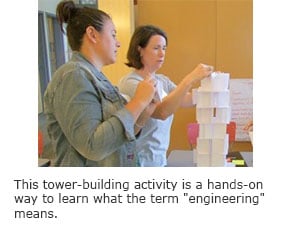
We were excited to welcome educators from across the nation in Boston last week for the annual meeting of the National Science Teachers’ Association (NSTA). One conference strand was “Engineering and Science: Technological Partners”—a very timely topic! The new Next Generation Science Standards (NGSS) put unprecedented emphasis on engineering as part of K-12 STEM instruction. In fact the standards recommend that engineering be raised “to the same level as scientific inquiry when teaching science disciplines.” But school days are already crowded. Adding engineering to the mix can sound daunting—especially if you don't have much experience with science or engineering.
EiE offers professional development workshops for elementary teachers, and as we developed our workshops, we identified three key understandings that help teachers feel more prepared to address the new standards. These understandings may seem simple, but our workshop graduates tell us they’re hugely important.
1. Engineers solve problems
First of all, it’s very common to have misperceptions about what, exactly, the term “engineering” means. Many people—not just teachers!--think of engineers in fairly narrow terms: engineers build large structures, such as bridges or skyscrapers, or they work on/fix computers. We help teachers to arrive a clear definition of engineering: as a systematic approach to solving problems—all kinds of problems!--in ways that make peoples’ lives easier and better.
2. Technology is what humans make or do to solve problems
Second, the term “technology” tends to be just as misunderstood as “engineering.” In particular, many people assume a technology is “something powered by electricity.” We’ve developed exercises that help participants broaden their definition of technology to include “anything that humans make to solve a problem.” Sure, computers and cell phones are highly engineered technologies—but so are devices that not only don’t plug in, they have no moving parts--like soupspoons and shoehorns. This simple understanding of what a technology really is can bring about a revolutionary shift in thinking.
3. Systematic research and testing are an important part of engineering
Even teachers who have strong backgrounds in science may find the new NGSS quite complex and challenging to understand. The final key to making connections between the three dimensions of NGSS (disciplinary practices, disciplinary core ideas, and cross-cutting concepts) is understanding that engineers don’t just think up solutions to problems, they also test their solutions against a standard set of criteria.
This core understanding stays front and center as students move from kindergarten and elementary school to middle and high school; the specific classroom exercises just become more sophisticated. For example, under the NGSS performance expectations, very young children should be able to recognize what kinds of problems can be solved by engineering; older children should be able to conduct background research, develop different solutions to a problem, and test these solutions and see which one works better.
We’ve developed a handy document that shows how Engineering is Elementary units link to NGSS performance expectations for each elementary grade. We hope you’ll find it helpful as you plan for the 2014-2015 school year. And check our website for other guides that how EiE links to ITEEA and state standards.
Engineering is Elementary is a project of the National Center for Technological Literacy at the http://www.mos.org/.








